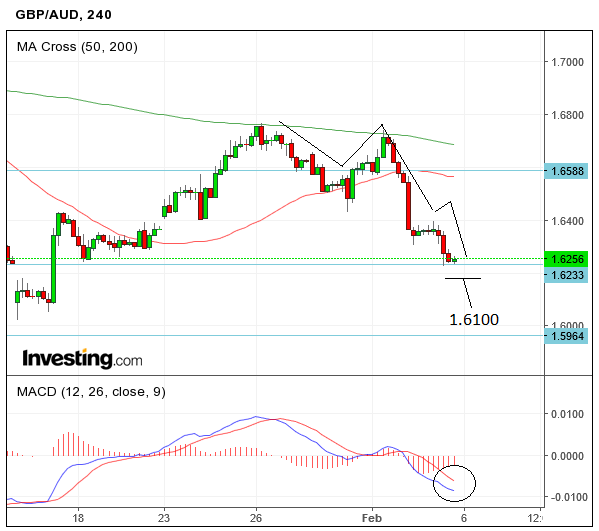GBP/AUD Exchange Rate: Weakness to Extend but Watch RBA Mid-Week

The Australian Dollar continues to defy bearish fundamental forecasts as it tracks higher versus the British Pound.
At the start of the new week we see the GBP/AUD exchange rate trading at 1.6271, notably lower from where it started the month towards 1.66.
From a technical perspective, the charts show a slight bearish bias now the pair has completed two lower lows and two lower highs on the four-hour charts.
Thus established, the mini downtrend is expected to extend lower, with a clear break below 1.6200 confirming a forecast to extend down to a target at round-number support at 1.6100.
The MACD has moved below its zero-line supporting the bearish outlook.
Australian Dollar Weakness in February
The Australian Dollar has performed well against its major peers since the start of 2017.
However, this outperformance could be about to come to an end owing to a “cyclical phenomena” that tends to impact the commodity Dollar bloc at the start of every new year.
“The most recent strength may also reflect a common phenomenon in the G10 commodity currencies – a tendency to overshoot in January," says a note from RBC Capital Markets.
Analysts at the Canadian bank have looked at the evidence for this phenomenon across a broad range of currencies and found quite convincing evidence that January moves tend to reverse in AUD, CAD, and NZD.
“A simple strategy of positioning for a reversal of January’s direction in the remainder of Q1 is consistently profitable in these three currencies,” says RBC’s FX Strategist Adam Cole.
If this is indeed true, then the downside in GBP/AUD could be protected.
We would however caution against expecting a rapid recovery rally in GBP.
Australian Dollar: What to Watch this Week
The Reserve Bank of Australia (RBA) release their first Statement of Monetary Policy of 2017 this year on February 8.
The RBA minutes for the December meeting emphasised the concern the Governing Board has with balancing the risks around financial stability which argue against further interest rate cuts and the possible need to further support a deteriorating economy which argue the potential for further cuts.
In addition, the minutes put a positive spin on the current economic outlook – consumer spending passing through a soft patch; non mining investment being a bit stronger than the most recent capital expenditure survey indicates; the fall in the unemployment rate being consistent with the hours worked data; and the drag from mining investment likely to ease markedly in 2017.
"A reasonable interpretation of this discussion is that the “hurdle” to further cutting rates is high," says a note ahead of the event from Westpac Bank. "These sentiments are certainly consistent with our long held view that rates are likely to remain on hold over the course of 2017."
Analysts at TD Securities meanwhile expect the RBA to downgrade its GDP forecasts in next week’s but the magnitude of the declines, the timing and how the GDP forecast for 2018 unfolds will be key.
Any bearish stance could cap AUD strength we believe.
Expect a Weakening of the Pound
Despite the New Zealand Dollar unlikely to find any notable fundamental drivers in the near-term, when compared with Sterling we would note it benefits from political stability and strong economic growth.
The Pound weakened in early February after the Bank of England (BOE) revised up growth forecasts but kept inflation forecasts unchanged while communicating no interest rate rises are likely in the foreseeable future.
The Bank's projections, and the Pound's continued underperformance thanks to uncertainty concerning Brexit have kept - and are likely to keep - the Pound subdued.
“We confirm our expectations for a possible – albeit modest – weakening of the Pound in the near term, mostly due to the new phase of uncertainty that will begin once the Brexit process is officially triggered,” says Asmara Jamaleh, an analyst with Intessa Sanpaolo.
On this front, a three-day debate on a law giving May the right to trigger Britain's exit from the European Union begins on Monday, and will be followed by a series of votes on whether to attach extra conditions to her plan to start talks by March 31.
Important amendments to the Bill will be discussed during debates leading up to the vote on Wednesday, which could impact how ‘Hard’ or ‘Soft’ Brexit could be.
One proposed amendment would be to discuss whether the UK should exit the common market as well as the EU before withdrawing.
Another asks for Parliament to be regularly updated by the government on the, “advancement of the negotiations".
Parliament may ask for further powers, including the power to vote to approve the agreement after negotiations are completed with the EU - and to extend negotiations in order to reach a better agreement.
Then there may also be amendments to protect the right of EU citizens living in United Kingdom and the request for an assessment of the impact of Brexit on specific sectors, such as climate change, social inequality, and public finance.
Once the vote in the Commons is passed the House of Lords will have their turn to debate and vote on the Bill on February 20.
It is then expected to be implemented on March 7.
Keep an eye on headlines - if there are signs Parliament is gaining an upper hand, and winning concessions we believe it would be positive for Sterling and with the currency under so much pressure we would argue risks are to the upside
Data to Watch
From a data perspective, the big release will be Manufacturing and Industrial Production on Friday, February 10, at 9.30 GMT.
Analysts estimate a downtick to 0.4% from 1.3% previously for Manufacturing, and Industrial Production slowing to 0.2% from 2.1% in December.
The Trade Balance, also released on Friday is expected to show a narrowing of the Deficit to -11.4bn from -12.16bn in December.






